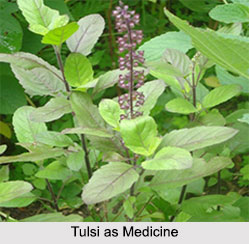 Tulsi or Ocimum sanctum has been used for thousands of years in Ayurveda for its diverse healing properties. Tulsi is termed as the Queen of herbs and is one of the holiest and most cherished of the many healing and healthy giving herbs of the orient. Sanskrit writers make two varieties of this plant founded upon some difference in the colour of their leaves namely, white and black. Tulsi is held sacred to Lord Vishnu of the Hindu trinity, and is reared in every Hindu house where it is daily watered and worshipped by all the members of the family. The beads or rosaries used by orthodox natives for counting the number of recitations of their deity"s name are made of the stems of this plant. The sacred Tulsi is renowned for its religious and spiritual sanctity, as well as for its important role in the traditional Ayurvedic and Unani medicine. Marked by its strong aroma and astringent taste, it is regarded in Ayurveda as a kind of "elixir of life" and believed to promote longevity.
Tulsi or Ocimum sanctum has been used for thousands of years in Ayurveda for its diverse healing properties. Tulsi is termed as the Queen of herbs and is one of the holiest and most cherished of the many healing and healthy giving herbs of the orient. Sanskrit writers make two varieties of this plant founded upon some difference in the colour of their leaves namely, white and black. Tulsi is held sacred to Lord Vishnu of the Hindu trinity, and is reared in every Hindu house where it is daily watered and worshipped by all the members of the family. The beads or rosaries used by orthodox natives for counting the number of recitations of their deity"s name are made of the stems of this plant. The sacred Tulsi is renowned for its religious and spiritual sanctity, as well as for its important role in the traditional Ayurvedic and Unani medicine. Marked by its strong aroma and astringent taste, it is regarded in Ayurveda as a kind of "elixir of life" and believed to promote longevity.
Health Benefits of Tulsi
The leaves are regarded as anti catarrhal or expectorant and are used in catarrh, cough and pain in the sides.
Dose of Tulsi in Medicine
The juice of the leaves is given with the addition of black pepper in catarrhal fever. It is often used as an adjunct to metallic preparations, which are rubbed with it into a thin paste and then licked up.
The leaves enter into the composition of some compound decoctions for cough and affections of the chest. The following is an example. Take the leaves of Ocimum sanctum, gulancha, ginger, root of Clerodendron Siphonanthus (bhargi) and Solanum Jacquinii (kantakari), equal parts and prepare a decoction in the usual way. The dried leaves are used as snuff in ozaena. They also enter into the composition of some compound medicines used in this disease, as for example of an oil which is prepared with a paste of the leaves of Ocimum sanctum, roots of Solanum Jacquinii (kantakari), Baliospermum montanum (danti), Acorus Calamus (vacha), Moringa pterygosperma (sigru), long pepper, black pepper and ginger.
Related Articles
Ayurveda
Origin of Ayurveda
Ayurveda Medication
Elements of Ayurveda
Concepts of Ayurveda
Ancient Literature of Ayurveda
Sushruta Samhita




















